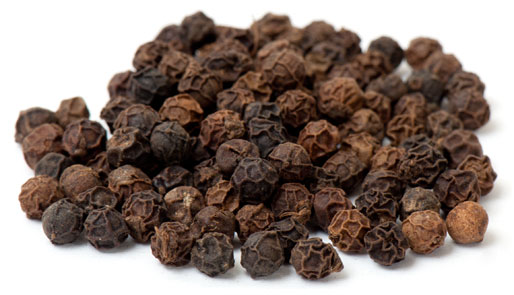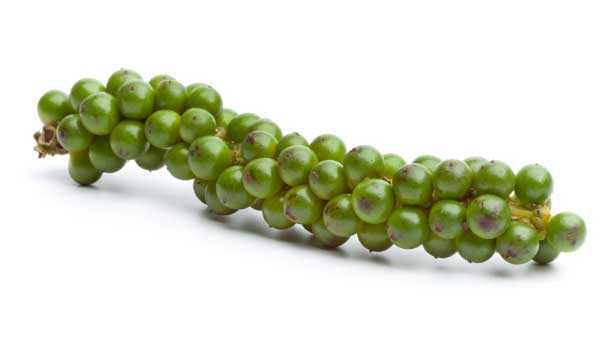First of all let's get technical because All Pepper varieties belong to the Piperaceae family and derived from the same vine (Piper nigrum). Pepper is a native of southern India. Today the largest producers of pepper are Vietnam, which is the biggest exporter in the world, India, which is the first consumer, Indonesia, Malaysia, Brazil and Madagascar.
The pepper plant is a long stem creeper, up to 10 m. Its fruits are small spherical berries. Different varieties result from picking the berries at various stages of ripening and processing them differently.
The Brief History
Pepper has been popular for more than 4000 years; cultivation of pepper began about 1000 BC.
Pepper was actually the first spice used in Europe and helped to motivate the Spanish, English, and Dutch to find trade routes to India. It helped develop the relations among East, West, and Middle East countries. This spice was a luxury and only used by the upper class up until the early 1800s before average citizens could afford to use this spice. This spice is so valuable that even in some parts of Asia, poorer families hold peppercorns as a type of savings.
The spice dates back much further than these somewhat modern trade routes though. It was highly prized in ancient Greece, being given as an offering to the Gods, used for paying taxes, and even in paying ransoms. Some of the ransoms were paid to the Ottoman Tribes. Rome also utilized pepper for taxes. The famous Roman Centurions received peppercorns as part of their pay.
The Middle Ages saw the price of pepper equal that of gold. The upper class often kept stores of it and accepted it as payment for rent and other debts. One pound of peppercorns was worth three weeks of work during this time frame.
Pepper is known as the king or master spice because even today it makes up about a quarter of the spice trade. Historically, it was a popular spice to use because it flavored bland food and covered up any signs of spoilage.
BLACK PEPPER
This will be the most common form of pepper in the USA. Black peppercorns are produced by picking the mature but unripe berries as they are beginning to turn from green to yellow. They are then boiled briefly and then allowed to ferment and dry naturally in the sun (or by forced-air heating) until wrinkled and black.
Black Pepper is moderatly hot, pungent and aromatic.
Varieties are,
Malabar: is the "original" pepper and is a popular variety that originates from the Malabar Coast in the SW portion of India, where peppercorn cultivation first began. The berries have a slightly greenish hue. This is an excellent pepper with pungent aroma and robust flavor available at a modest price. This variety represents for many what "pepper" should smell and taste like.
Tellicherry: comes from the same region as Malabar and is a family of quality designations representing the largest and highest quality berries, and is widely recognized as a premium product with more name recognition than any other variety. These berries are picked much closer to fully ripe than the Malabar, as the berry color reaches yellow-orange or even red. The color is a dark chocolate brown to black and the flavor is highly complex and aromatic. Tellicherry peppercorns are large in size and have a complex spicy aroma and slightly more heat with hints of cedar, flowers and cherries. The complexity in aroma and flavor comes at the expense of pungency, which is why some tastes prefer Malabr.
Sarawak Black: In recent years the Malaysian Pepper Board has encouraged growers and processors to experiment with techniques such as rapid harvesting and collection and forced air drying, aimed at increasing product quality rather than reducing costs, and these efforts are paying off. Premium Sarawak Black pepper is a medium-sized pepper with brown-grayish hues. It has a mild flavor with a fresh aroma that is often described as fruity with hints of chocolate, licorice and syrah.
Lampong: comes from the island of Sumatra in Indonesia and is similar in some respects to Sarawak except for being hotter. This is the variety most often sold in the UK. Lampong peppercorns have an earthy and smoky aroma. This peppercorn is slightly smaller in average size than others.
Vietnamese: Some of the world's best spices are coming from Vietnam these days and their pepper is no exception. This pepper is often compared to Lampong but I find the berries to be much larger and with a pleasant lemony/citrus aroma and taste that is different from Lampong.
Kampot: Hailing from Cambodia, Kampot is an organic, luscious black peppercorn that is crisply sweet in fragrance with overtones of guava and eucalyptus. It is a large berry with an equally large paper-white center that ensures good heat.
Madagascar: This is another variety largely unknown to American Chefs. Madagascar was once a colony of France, and the close relationship continues with most of their peppercorns being exported to there. Madagascar pepper features a medium sized berry, brownish-gray in color, with a rich aroma reminiscent of hickory smoke or charred oak barrels. The flavor is mild and not too hot.
Penja Black: The Penja Black Peppercorn is a small to medium-sized peppercorn with a uniform dark brown/black color. The aroma is rich and pungent with a hint of Cumin. The flavor is also pungent with a high heat that.
GREEN PEPPERCORNS
These are berries that are picked long before maturity in the green stage and either air-dried, freeze-dried or pickled in brine to prevent fermentation. They are aromatic with a fresh flavor, but are not pungent. In the dried form they are considered essential for French, Creole and some Thai cooking. This is the also the pepper called for in a traditional "peppercorn" sauce.
Because of the extra processing required and the smaller yield, these are some of the more expensive peppercorns. In recent years Brazil has become the chief source for this variety if you are able to find them at all.
Red Peppercorns
Red peppercorns are fully ripened berries that are bright red in color when they are picked.
They may be used fresh, but they spoil quickly, so they can be preserved in brines, freeze-dried, or air dried.
The aroma is complex with little pungency, and the flavor is hot.. (Is this respect the flavor is very similar to what you get with the highest grades of Tellicherry, as those berries are almost ripe when picked.)
CUBEBE PEPPER (PIPER CUBEBA)
Cubebe pepperbelongs to thePiperaceae family. It grows wild and is cultivated in the islands of Java and Sumatra in the Malay Archipelago, as well as in the West Indies and in few African areas.
Its berries are very similar to those of black pepper variety. They have a small beard which isthe stalk by which they were on the plant.
They are harvested before reaching full maturity. The pericarp of the berry is brown or blackish, while the seed inside is whitish, resinous.
NOT TRUE PEPPER
Szechuan peppercorns: Szechuan (Sichuan) peppercorns are not a true pepper at all, but berries from the Prickly Ash tree native to China. It is widely grown and consumed in Asia and is a vital component in many Chinese and Japanese dishes. The peppercorns are air-dried rust-colored berries with hair-thin stem connecting to a split husk containing a black seed. The husk and the seeds are often separated as they have different flavors.
Szechuan peppercorns have an aromatic and resinous flavor that leaves the lips tingly and slightly numb when tasted directly followed by a moderate heat that lingers. The peppercorns are often lightly roasted before crushing in a mortar and pestle.
Long pepper (Piper longum): sometimes called Indian long pepper (pipli), is a flowering Vine in the family Piperaceae, cultivated for its fruit, which is usually dried and used as a spice and seasioning. Long pepper has a taste similar to, but hotter than, that of its close relative Piper nigrum - from which black, green and white pepper are obtained.
The fruit of the pepper consists of many minuscule fruits — each about the size of a poppy seed — embedded in the surface of a flower spike that closely resembles a hazel treecatkin. Like Piper nigrum, the fruits contain the alkaloidpiperine, which contributes to their pungency. Another species of long pepper, Piper retrofractum, is native to Java, Indonesia. The fruits of this plant are often confused with chili peppers, which belong to the genus Capsicum, originally from the Americas.
Pink peppercorns (shinus molle): This pepper is grown in Madagascar, Mexico and Australia. The pale pink berries are harvested in the summer. Initially this has a pepper flavor but ends tasting sweet. It is good for vegetables and seafoods and is not a good replacement for regular pepper.
This can cause an allergic reaction in children so follow the recipe precisely.
The schinus terebinthifolius species is also used as a pink pepper. The plant looks similar to a holly tree and is grows in parts of the US like the shinus molle. There is an additional pink peppercorn which comes from the Baies rose plant (euonymus phellomanus) which is also from Madagascar. Pink peppercorns (shinus molle) is grown in Madagascar, Mexico, and Australia.
Photographer: Robert J Gibbons
Negro Pepper (xylopia aethiopica): Negro Pepper is grown in Ghana and Malawe. This pepper is harvested in the fall and when dried has dark brown seed pods. Like the piper nigrum, it is fruit which is dried in the sun. Also similar to piper nigrum, this has a strong flavor but it leaves a bitter after taste so is not a good substitute for regular pepper.















